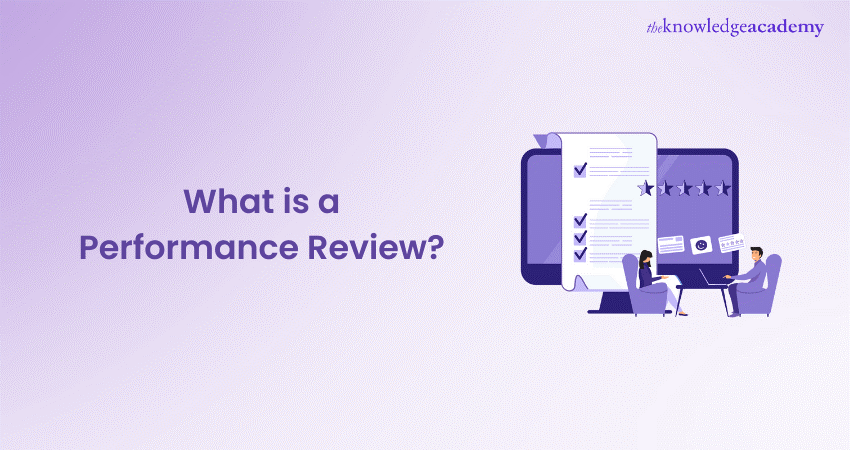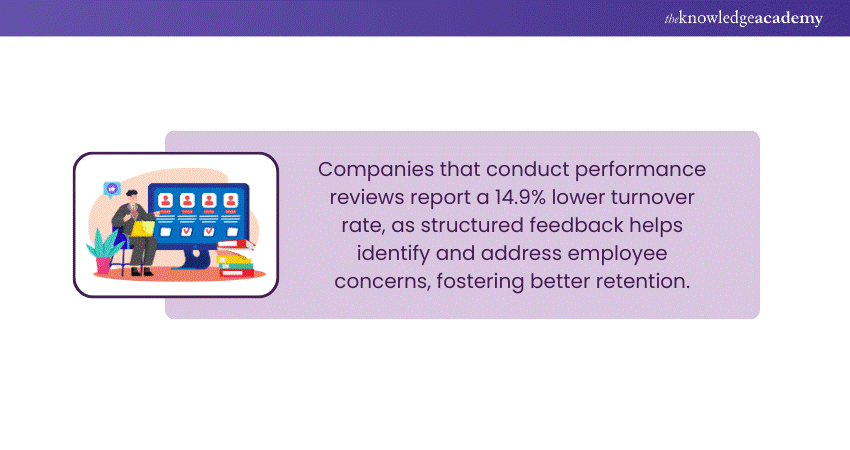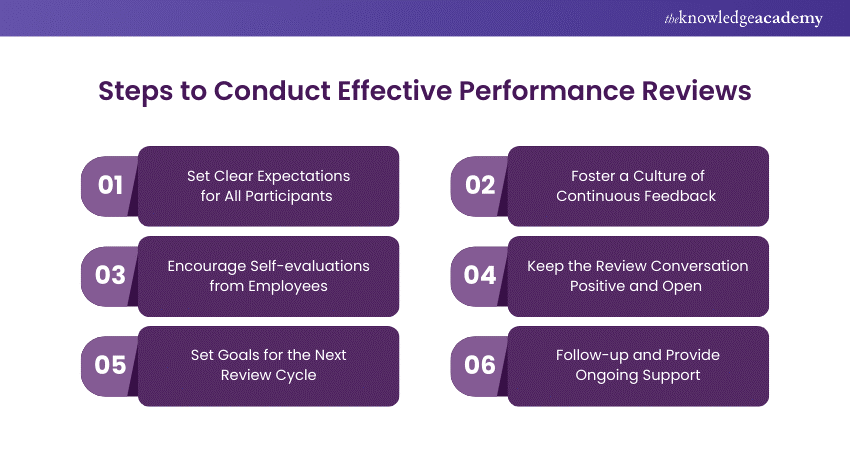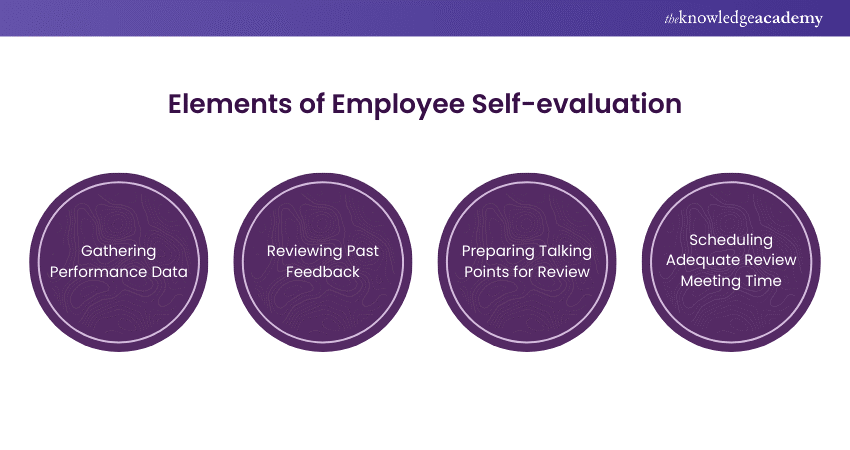We may not have the course you’re looking for. If you enquire or give us a call on +41 315281584 and speak to our training experts, we may still be able to help with your training requirements.
Training Outcomes Within Your Budget!
We ensure quality, budget-alignment, and timely delivery by our expert instructors.

If you're a part of an organisation, one of the most daunting rituals you must go through is the performance review! It can be a challenge regardless of which side of the review you are in. Think of it like a professional heart-to-heart between managers and Employees that spotlights the achievements and shortcomings in eye-opening measures.
But what exactly does a performance review entail, and how does it drive overall organisational productivity? This blog answers these questions by delving into the various categories of Performance Reviews and outlining the best tips for conducting one. So read on and monitor the progress of your organisation like a pro!
Table of Contents
1) What is a Performance Review?
2) Different Types of Performance Reviews
3) Steps to Conducting Effective Performance Reviews in an Organisation
4) Seven Performance Review Comments to Avoid
5) Tips for Conducting Effective Employee Performance Reviews
6) Conclusion
What is a Performance Review?
A performance review refers to a formal assessment in which a manager evaluates an employee’s performance at work. Also known as an employee evaluation or a performance appraisal, it can be structured in numerous ways to effectively identify strengths and weaknesses, provide constructive feedback, and set goals for the future.
It is usually a two-way, individualised conversation between managers and employees about impact, development, and growth in performance. It’s a vital component of a continuous Performance Management approach that helps evaluate and propel success for the team, the employee, and the organisation.
Different Types of Performance Reviews
There are many different approaches to performance reviews including the multi-rater and single-input reviews. Regardless of the choice, a performance review process must fit the organisational culture and be relevant and meaningful for both the manager and the employee. Let's break down the three vital categories of performance reviews:
1) Continuous Performance Conversations
Continuous performance conversations address what's happening in the current moment emphasising the importance of immediacy. It enables managers to coach on what matters now and provides employees space for agility and change. Consider the following examples of continuous performance conversations:
a) Annual Performance Review: An annual performance review has an important role. It allows employees and managers to look back and celebrate a year’s worth of challenges, growth, contributions, and accomplishments.
b) Mid-year Performance Review: Consider a mid-year cadence if quarterly or monthly performance conversations aren’t feasible for your organisation. Mid-year performance reviews are good enough to allow for adjustments and modifications for the rest of the year.
c) Quarterly Performance Review: Regular performance check-ins are ideal because they create a mindset that development and progress are more important than perfection. At a minimum, a quarterly check-in is a perfect cadence for reviewing performance with a future-focused mindset.

2) Multi-rater Performance Reviews
Multi-rater reviews have been around for quite some time and are still an integral part of the modern approach to performance review. These include multiple perspectives and voices, as most work is done and evaluated through matrixed teams. Consider these tasks of multi-rater performance reviews:
a) 360 Performance Review: Evaluative feedback is at the heart of a 360 performance review. These reviews help aid performance data and measurement, offer unique vantage points and perspectives, and show leaders where they can improve.
b) Self-assessment: A self-assessment aims to improve shared accountability, buy-in, and alignment between manager and employee. The manager receives insight into Coaching and guiding the employee better, and the employee can discuss their performance with their manager's perception.
c) Peer Review: Peer feedback is essential because peers have a unique vantage point to share ideas and insights and can often be trusted confidants or mentors. Most importantly, recognition means more when it comes from peers.
d) Upward Feedback: Upward feedback, when approached with a healthy mindset by both employees and managers, is a powerful tool for mutual growth. It helps both parties realise they are in this together.
3) Performance Conversations
Performance conversations should be flexible and incorporate every aspect of overall employee performance. Consider the following examples of performance conversations by topic:
a) Professional Development: Professional development must be a regular part of performance conversations. Employees who grow feel like they are moving forward, helping fuel their performance.
b) Behaviour Change: Outdated performance processes will not motivate, inspire, or drive performance (or engagement). Organisations that are not adaptable, agile, or innovative won't survive in the competitive climate—so employees must be comfortable and successful in that environment.
c) Compensation Check-in: Compensation check-ins are performance conversations that set expectations. These types of discussions must happen regularly, and must create transparency for managers, employees, and leaders.
Steps to Conducting Effective Performance Reviews in an Organisation
Performance reviews create a sense of fairness in an organisation. When everyone knows their efforts are being recognised and evaluated, it goes a long way in boosting motivation and teamwork. Let's explore the essential steps of conducting an ideal and inspiring performance review

1) Set Clear Expectations for All Participants
Think of it as laying the groundwork. When everyone knows what’s expected of them, the performance review process is smoother and less stressful, ensuring fairness. Here are the actionable steps:
a) Defining Review Goals: Be it employee development, salary adjustments, or both, begin by explicitly stating the objectives of the performance review guide.
b) Documenting Review Criteria: Laying out the specific criteria and key performance indicators (KPIs) is essential.
c) Scheduling Review Cycles: Define a regular schedule for performance reviews and ensure that this timetable is well-communicated to every employee.
d) Offering Training: The managers must be trained in the art of conducting effective reviews, which encompasses aspects of objectivity and adept communication.
e) Communicating Expectations: Be unequivocal in conveying what employees should expect from the review process. Specify the timeline, format, and how feedback will be shared.
Sign up for our Human Capability Development Program Course and foster a culture of continuous improvement in your organisation!
2) Foster a Culture of Continuous Feedback
A culture of continuous feedback helps with improvement and prevents unwelcome surprises during formal reviews. Here are some actionable steps to foster an environment of open dialogue year-round:
a) Promoting Regular Check-ins: Managers must be encouraged to meet with their team members regularly. These sessions should revolve around challenges, progress, and objectives.
b) Providing Tools and Resources: Equip your teams with the necessary tools, such as feedback templates, 360-degree feedback systems, or Performance Management tool.
c) Recognising and Rewarding Feedback: Employees and managers who actively participate in constructive feedback must be acknowledged and rewarded.
d) Leading by Example: The HR team and senior leaders must set a precedent by constructively practicing the art of giving and receiving feedback.
e) Addressing Issues Promptly: Managers must be encouraged to tackle performance issues in real-time rather than waiting for the annual review.
3) Encourage Self-Evaluations from Employees
Self-evaluations empower employees to take charge of their performance and career development. They offer a unique perspective and stimulate self-awareness. This includes:

a) Gathering Data: Managers must compile performance data and feedback gathered throughout the review period.
b) Reviewing Past Feedback: Managers must revisit feedback from previous reviews to track progress and detect recurring themes.
c) Preparing Talking Points: Managers and employees must be encouraged to outline key points for the review, ensuring they address achievements and improvement areas.
d) Scheduling Adequate Time: Sufficient time must be allocated for the review meeting, ensuring it is unhurried and uninterrupted.
4) Keep the Review Conversation Positive and Open
Encouraging a constructive and open dialogue during reviews ensures that employees feel valued. Consider the following points to create an environment where feedback can lead to growth rather than defensiveness:
a) Active Listening: Managers must actively listen to employees, allowing them to express their viewpoints and concerns.
b) Positive Language: Phrases like “growth opportunities” should be prioritised over “weaknesses.” It's important to frame feedback in a positive, future-oriented manner.
c) Open-ended Questions: Managers should ask open-ended questions that promote self-reflection.
d) Avoiding Comparisons: Comparing employees to each other must be discouraged, as it can lead to unhealthy competition.
e) Seeking Employee Input: Managers must inquire about employees’ career goals and aspirations. This is a way of involving them in the goal-setting process for the future.
5) Set Goals for the Next Review Cycle
Setting clear and attainable goals is essential for keeping employees motivated and elevating their performance. It provides employees with a roadmap for their development. Consider the following points:
a) Reflecting on Feedback: Managers and employees must reflect on the feedback from the current review.
b) Identifying Development Areas: It's crucial to pinpoint specific areas where improvements or skill development are needed.
c) Setting SMART Goals: Managers and employees must create Specific, Measurable, Achievable, Relevant, and Time-bound (SMART) goals.
d) Document Goals: Plans must be documented and shared with both parties, outlining the action steps and milestones.
e) Schedule Check-ins: It's important to establish a program for regular check-ins between reviews to track progress on goals.
6) Follow-up and Provide Ongoing Support
The post-review phase is vital as this is where the plans and commitments made during the review come to life. Here are the key points to remember about this phase:
a) Providing Resources: Employees must have access to training, resources, and mentorship to achieve their goals.
b) Recognising Achievements: Achievements and milestones reached along the way must be acknowledged and celebrated.
c) Adjusting and Adapting: It's important to be open to adjusting goals if new circumstances arise.
d) Continuous Feedback: Open channels for feedback must be encouraged to address evolving needs and aspirations
Want some guidance regarding maintaining high productivity with minimum resources? Then look no further than our Introduction to Managing People Course – Sign up now!
Seven Performance Review Comments to Avoid
To ensure that performance evaluations are successful, managers and employees alike should be prepared to discuss and reflect together. However, since managers have the authority to affect their employees' careers substantially, it's their job to facilitate a productive conversation. Here are seven topics managers should avoid at all costs kto eep the discussion constructive:

Speculation
Raising hopes for a promotion that may not be possible or sharing rumours about the company causes unnecessary speculation and disappointment. For example, if an employee makes a query about pay raises, you can be honest and say that upper management is reviewing the budget. However, it’s best not to predict which way they’re leaning.
Repetitive Remarks
Some essential things bear repeating, but it's okay to change things up if the same advice and praise are repeated in every performance evaluation. Maybe the message isn’t getting through the way it's being shared, or it needs further discussion. If managers and employees keep notes of the talking points in performance reviews, the goals and advice can be used as a foundation to build something new instead of repeatedly rehashing the same thing.
Comparisons with Others
Focusing only on the performance of the employee being evaluated is vital because this isn't a space to pit employees against each other. For instance, if John from the sales team met his sales goal for the month, it wouldn't be appropriate to say something like "Tom doubled his sales goal this month, let's see if you can hit those numbers next". Such comparison will diminish John's achievement.
Insincere Praise
While it's important to say something positive in every performance review, avoid giving false praises. This can only mislead employees into thinking they're doing better than they are and rob them of any opportunity to improve.
Absolutes Like "Always" and "Never"
Blanket statements and ultimatums are rarely accurate and can make people feel defensive. For example, if an employee who usually meets deadlines has been late in submitting the last two assignments, avoid saying things like, “You never hand your work in on time.” Instead, invite the employee to be honest about why they were late and problem-solve together for future tasks.
Mentioning Lack of Time
Even if your company only conducts one formal employee review a year, it's important to let the employees know they are welcome to keep discussing their evolving goals during the casual weekly one-on-ones and other times. Conveying this will let your team know their growth and development are valued.
Criticism Without Concrete Examples
Citing an example and offering ideas for improvement can help employees improve their performance rather than make them feel defensive. For example, instead of saying, “I'm not pleased with the quality of your work,” more constructive feedback can be provided, such as “I think the quality of your work could be improved if you focused on [Responsibility].”
Tips for Conducting Effective Employee Performance Reviews
Consider these tips to ensure that the performance review goes in a timely and smooth manner:
1) Set Your Intention: Start with a performance review checklist and set your objectives with a Performance Management template.
2) Run Performance Reviews Frequently: Performance reviews are more impactful when they occur more than once a year. Bi-annual or quarterly feedback enables professionals to keep a finger on the pulse of their performance.
3) Take a Growth-minded Approach: It's all about walking the fine line between praise and critique. While celebrating people’s accomplishments is essential to fuel motivation, pointing out poor performance is equally important.
4) Make the conversation two-way: Managers and team members must maintain a two-way conversation between them. Keeping an open line of communication nurtures an honest, respectful, and long-term relationship.
5) Keep Professionals in the Know: Provide team members (especially new employees) ample notice of the performance review date and also an overview of the discussion topics.
6) Mediate: It's not unusual for tensions to arise between a manager and a team member. You must work to tip the scales in a positive direction so that each side finds common ground and work towards an agreement.
7) Analyse and Organise the Results: To ensure performance reviews are impactful, the results must be examined, and the low performance levels must be investigated. Entering the results into the company’s Performance Management software can help you easily track work performance.
Conclusion
In conclusion, a Performance Review refers to the structured assessment of an employee's performance and associated organisational contributions. It's a vital tool for nurturing growth, aligning goals and elevating overall productivity. With the various tips and steps outlined in this blog, navigating the Performance Review process will be a breeze for you.
Struggling to align individual and team goals with organisational objectives? Our comprehensive Performance Management Training is here to help you - Sign up now!
Frequently Asked Questions

A 5-word performance review is a concise method of providing feedback. which typically includes a mix of positive and constructive comments. Examples include:
a) “Needs improvement in time management.”
b) “Consistently exceeds expectations, great job!”
c) “Excellent team player, very reliable.”

The primary objective of performance reviews is to provide information on employee performance for decision-making regarding compensation, promotions, and development plans. It helps in gathering intelligence for organisational strategies.

The Knowledge Academy takes global learning to new heights, offering over 30,000 online courses across 490+ locations in 220 countries. This expansive reach ensures accessibility and convenience for learners worldwide.
Alongside our diverse Online Course Catalogue, encompassing 19 major categories, we go the extra mile by providing a plethora of free educational Online Resources like News updates, Blogs, videos, webinars, and interview questions. Tailoring learning experiences further, professionals can maximise value with customisable Course Bundles of TKA.

The Knowledge Academy’s Knowledge Pass, a prepaid voucher, adds another layer of flexibility, allowing course bookings over a 12-month period. Join us on a journey where education knows no bounds.

The Knowledge Academy offers various Management Courses, including the Managing Remote Teams Course and the Performance Management Course. These courses cater to different skill levels, providing comprehensive insights into What is Performance Management Systems.
Our Business Skills Blogs cover a range of topics related to Performance Management, offering valuable resources, best practices, and industry insights. Whether you are a beginner or looking to advance your Performance Management skills, The Knowledge Academy's diverse courses and informative blogs have got you covered.
Upcoming HR Resources – Learn about Human Resources Batches & Dates
Date
 Performance Management Training
Performance Management Training
Fri 7th Feb 2025
Fri 4th Apr 2025
Fri 6th Jun 2025
Fri 1st Aug 2025
Fri 3rd Oct 2025
Fri 5th Dec 2025







 Top Rated Course
Top Rated Course



 If you wish to make any changes to your course, please
If you wish to make any changes to your course, please


